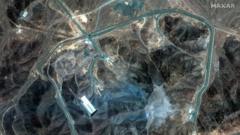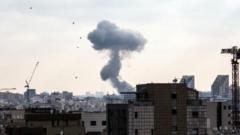In-depth analysis of satellite imagery has revealed that the United States launched targeted strikes on Fordo, Iran's underground nuclear enrichment facility, specifically targeting two structures that experts believe to be ventilation shafts. Observations from Maxar Technologies indicate these structures were first documented in 2009 but were concealed by 2011, possibly to secure the facility from aerial surveillance and attacks.
**U.S. Targets Iran's Fordo Nuclear Facility: Satellite Evidence Highlights Attack Strategy**

**U.S. Targets Iran's Fordo Nuclear Facility: Satellite Evidence Highlights Attack Strategy**
U.S. airstrikes focused on Iran's critical Fordo nuclear site, with intelligence suggesting an aim at its ventilation shafts.
Mark Fitzpatrick, a nuclear expert, pointed out that targeting the ventilation shafts makes strategic sense, given that they are likely the most vulnerable parts of the heavily fortified facility. A confirmed U.S. strike involved six B-2 bombers dropping twelve 30,000-pound "bunker buster" bombs on the site, with Scott Roecker from the Nuclear Threat Initiative emphasizing the innate weaknesses these shafts represent.
The extent of damage inflicted upon Fordo remains uncertain. Initial statements from President Trump celebrated the "complete destruction" of Iran's nuclear infrastructure; however, more cautious assessments are emerging from U.S. and Israeli military intelligence. Notably, recent satellite imagery depicts evidence of debris surrounding the complex while its support structures seemingly remain intact.
Joseph Rodgers, a nuclear strategy expert, suggested that the pinpoint targeting of what appears to be weaknesses in Fordo's structure indicates the U.S. possessed significant operational intelligence prior to the strikes. While debris was visible in satellite captures taken soon after the attack, the core support buildings remained standing, hinting at the attack’s intent to compromise underground functionality rather than incapacitate surface operations.
In analyses of recent satellite images of Fordo, signs of preparative actions by Iran have also surfaced. Reports documented a surge in activity around the facility, including the presence of cargo trucks and earth-moving equipment, suggesting that Iran was preparing defenses against a potential attack. After the U.S. strikes, satellite imagery displayed numerous entrance tunnels filled with dirt, indicative of Iran's efforts to shield the site from bombings.
This ongoing situation, rich with geopolitical implications, continues to evolve as assessments and intelligence emerge.
The extent of damage inflicted upon Fordo remains uncertain. Initial statements from President Trump celebrated the "complete destruction" of Iran's nuclear infrastructure; however, more cautious assessments are emerging from U.S. and Israeli military intelligence. Notably, recent satellite imagery depicts evidence of debris surrounding the complex while its support structures seemingly remain intact.
Joseph Rodgers, a nuclear strategy expert, suggested that the pinpoint targeting of what appears to be weaknesses in Fordo's structure indicates the U.S. possessed significant operational intelligence prior to the strikes. While debris was visible in satellite captures taken soon after the attack, the core support buildings remained standing, hinting at the attack’s intent to compromise underground functionality rather than incapacitate surface operations.
In analyses of recent satellite images of Fordo, signs of preparative actions by Iran have also surfaced. Reports documented a surge in activity around the facility, including the presence of cargo trucks and earth-moving equipment, suggesting that Iran was preparing defenses against a potential attack. After the U.S. strikes, satellite imagery displayed numerous entrance tunnels filled with dirt, indicative of Iran's efforts to shield the site from bombings.
This ongoing situation, rich with geopolitical implications, continues to evolve as assessments and intelligence emerge.























